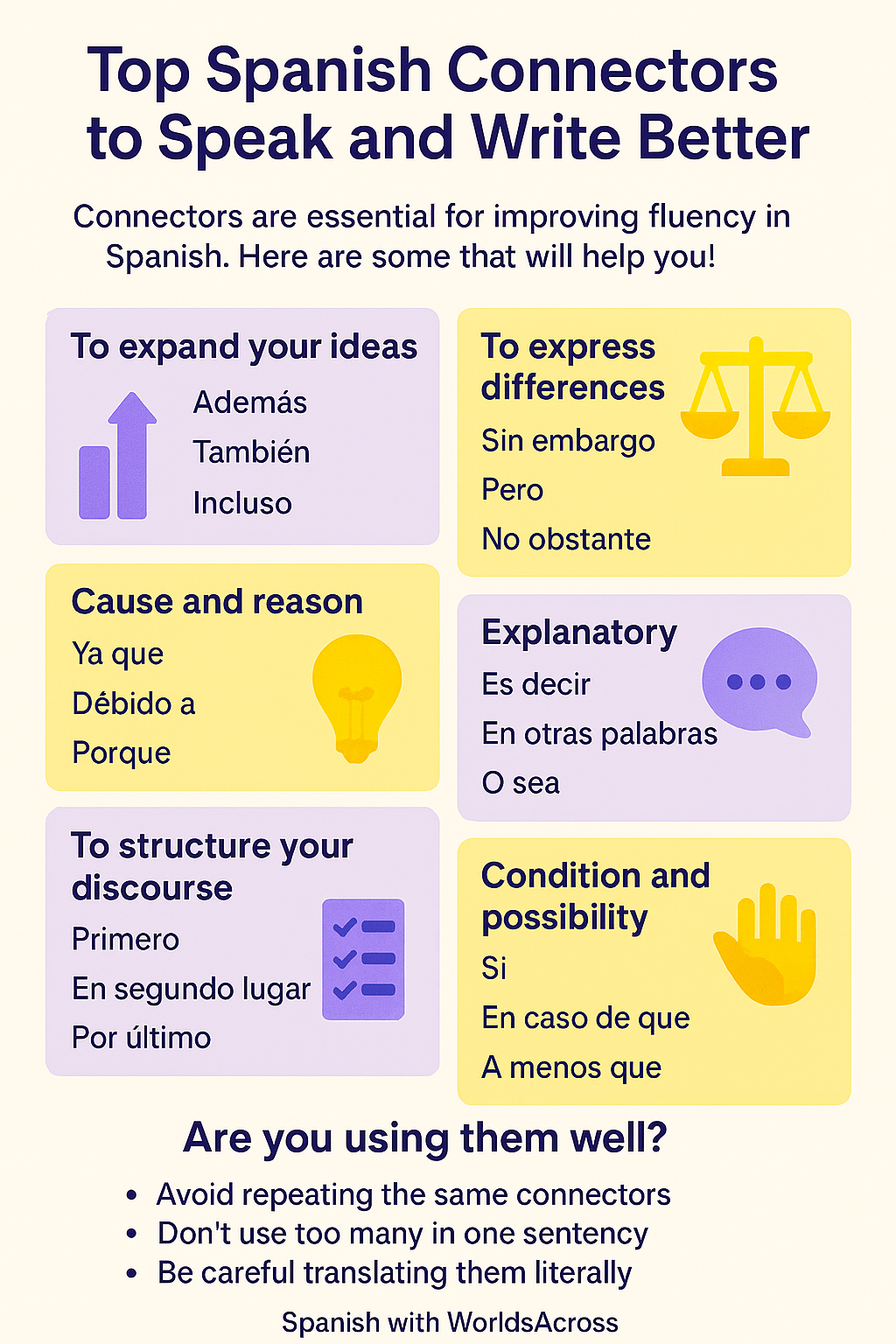Top Spanish Connectors to Speak and Write Better
During my last trip to Mexico, I met Austin, a British learner of Spanish who loved Latin American culture. His Spanish was impressive: he had a broad vocabulary and understood almost everything without trouble.
However, when he spoke, it felt like he jumped from one idea to another with no connection, which sometimes left me confused. At first, I didn’t know what was missing, but after a few minutes, I realized: Austin wasn’t using connectors in Spanish.
If you’ve ever felt like your ideas sound disconnected, you might be going through the same thing as Austin. But don’t worry! Today I’ll teach you the most important Spanish connectors so you can express yourself clearly in both speech and writing.
Let’s go!

How to Expand Your Ideas with Connectors
Connectors are essential for improving fluency in Spanish. They not only join ideas but also give your speech or writing a natural structure. Here are some useful connectors for adding information:
- Además (Moreover) – Voy a ir al spa. Además, ya necesitaba un tiempo para mí.
- También (Also) – Me gusta correr por las mañanas. También hago yoga en la tarde.
- Incluso (Even) – Puedo llevarte al centro comercial. Incluso, puedo acompañarte un rato si quieres.
Connectors to Debate and Express Differences
Adding opposing opinions makes conversations more interesting. Use these connectors to do it naturally:
- Sin embargo (However) – Me gustan los postres. Sin embargo, hoy preferí comida salada.
- Pero (But) – Mi plan salió bien, pero se me pasaron algunos detalles importantes.
- No obstante (Nevertheless) – El viaje es costoso. No obstante, la experiencia vale la pena.
Explain the “Why” with Cause and Reason Connectors
No guide to Spanish connectors is complete without those that explain reasons. They’re key to adding strength and clarity to your ideas:
- Ya que (Since/Because) – Pedí comida a domicilio ya que no tuve tiempo de cocinar.
- Debido a (Due to) – Pospusimos la reunión debido a un problema inesperado.
- Porque (Because) – Estoy aprendiendo español porque me encanta el idioma.
Clarify Your Ideas with Explanatory Connectors
Ever feel like your point needs a little extra push? These connectors are perfect for reinforcing your message and making it shine:
- Es decir (That is to say) – Para mejorar la fluidez en español, hay que practicar a diario, es decir, hablar, escuchar, leer y escribir en el idioma.
- En otras palabras (In other words) – Dormir bien es esencial. En otras palabras, si no descansamos, nuestro cuerpo y mente no funcionan al 100%.
- O sea (So/That is) – Este café está muy amargo, o sea, le falta azúcar.
The Perfect Order: Connectors to Structure Your Discourse
Giving a logical sequence to what you say helps make your message clearer. These connectors will help:
- Primero (First) – Para perder peso, primero debes cuidar tu alimentación.
- En segundo lugar (Second) – En segundo lugar, debes hacer ejercicio.
- Por último (Lastly) – Por último, la constancia es clave para ver resultados.
Connectors to Express Conditions and Possibilities
Want your message to have more nuance and sound more natural? Use these when you need to express conditions—they’ll be super helpful:
- Si (If) – Si me siento mejor, entonces iré a la fiesta.
- En caso de que (In case) – Trataré de llegar temprano. En caso de que no pueda, te aviso.
- A menos que (Unless) – Podemos cocinar algo, a menos que prefieras pedir comida a domicilio.
A Strong Finish: Connectors to Conclude Ideas
Well done! You now know several Spanish connectors. Let’s look at a few that will help you wrap up or summarize your ideas:
- En resumen (In summary) – En resumen, la película me gustó, pero el final no fue lo que esperaba.
- En definitiva (Ultimately) – En definitiva, aprender español es un desafío, pero vale la pena.
- En conclusión (In conclusion) – En conclusión, los conectores ayudan a estructurar mejor las ideas y a mejorar la fluidez en español.
Are You Using Them Right? Common Connector Mistakes and How to Avoid Them
Now that you’ve mastered these connectors, your ideas will be much clearer in speech and writing. But beware—there are common mistakes to avoid:
-
Repeating the same connectors all the time
There are many connectors. If you always use the same one, your speech will sound monotonous.
Incorrect:
Ya que quiero viajar a España, estoy ahorrando ya que es mi sueño, ya que es el país de mis abuelos.
Correct:
Como quiero viajar a España, estoy ahorrando, porque es mi gran sueño. Además, es el país de mis abuelos, así que significa mucho para mí.
-
Using too many connectors in one sentence
Connectors should make your ideas flow, not tangle them.
Incorrect:
Primero que nada, quiero ir al centro comercial porque voy a comprar ropa, además, hay ofertas, pero, sin embargo, no quiero gastar mucho, ya que, quiero ahorrar.
Correct:
Quiero ir al centro comercial para comprar ropa. Además, hay ofertas, pero tampoco quiero gastar demasiado.
-
Translating connectors literally from English
Some connectors look similar in English and Spanish, but they aren’t always equivalent.
- “By the way” → “Por la manera” (incorrect)
“Por cierto” (correct) - “On the other hand” → “En la otra mano” (incorrect)
“Por otro lado” (correct)
Improve Your Spanish with Connectors
And there you have it! Now you can take your conversations and writing to the next level with these Spanish connectors. Start using them today and let your Spanish flow with clarity and confidence in every word.
See you on the next language adventure!



